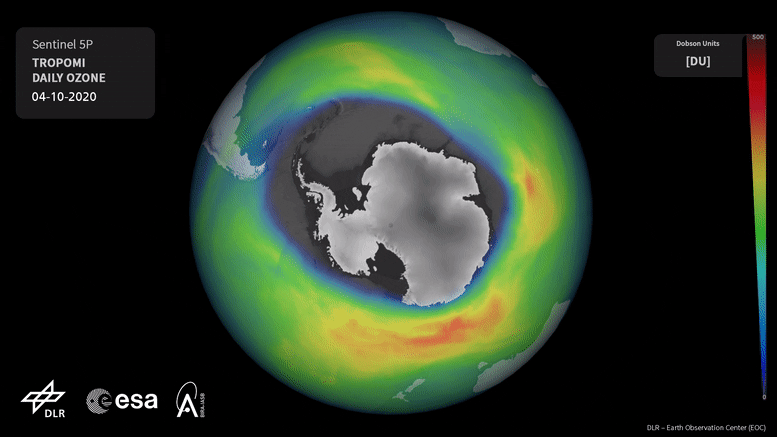
Earth’s Ozone Hole 2020. Credit: ESA
In the 1980s, scientists discovered a gaping hole in Earth’s ozone layer, caused by humanmade chemicals. But thanks to the historical Montreal Protocol, the world came together to take bold action to save our planet. Decades later, we can see the steady recovery of the ozone hole. How did we do it? And what does space have to do with it? Join us as we explore the journey of the ozone hole, from its alarming discovery to the incredible strides made to fix it, and how satellites are helping us track its recovery.
Video Transcript:
The 80s – some would say the coolest of all decades. But then news broke.
Scientists studying the atmosphere over the polar regions are now thoroughly convinced that man-made CFC gases have severely damaged the ozone layer.
[Music]
A hole in the ozone layer was discovered, and we were on track to destroy it by 2050.
Without the ozone layer, harmful radiation would reach us, with severe consequences for life on Earth.
But today, we all know the good news. Earth’s ozone layer is on track to make a full recovery.
In an unprecedented act, a landmark agreement was signed, preventing a potential environmental disaster. Well how did we do it and what does space have to do with it?
Let’s start with the basics. The ozone layer is a thin part of Earth’s atmosphere that absorbs most of the ultraviolet radiation from the sun.
When depleted, this radiation can reach the surface causing harm to humans and other living things.
[Music]
Ultraviolet rays damage DNA and cause sunburn, increasing the long-term risk of problems such as skin cancer.
So, what caused the ozone hole in the first place?
Chemicals used as refrigerants for air conditioners, spray cans, and refrigerators called chlorofluorocarbons were blamed for eating away at the ozone layer.
In 1985, scientists from the British Antarctic Survey discovered the extremely low ozone concentrations over Antarctica and raised the alarm.
They realized that the seasonal loss was getting worse each year. Shortly after, the Montreal Protocol was signed by every nation in the world. It restricts both the consumption and production of these ozone-depleting substances making it one of the most successful International agreements in history.
A remarkable thing, when considering that, is to remember that it only took two years for the world to take notice of the warning that the hole in the ozone layer was damaging the entire globe. For the nations of the world to take action and that saved the world from major damage.
Today the ozone layer is slowly recovering and is helping to Shield us from the devastating effects of ultraviolet radiation. And by 2050, it is projected to make a full recovery.
How do we make sure we’re on track?
Satellites orbiting above us combined with ground-based measurements are the best way to do this.
ESA has been monitoring the ozone for over two decades. Ozone data was provided by three key satellites: ERS-2, Envisat, and EUMETSAT’s Metop satellites.
Then in 2017, the Copernicus Sentinel-5P satellite was launched. Sentinel-5P with its Tropomi instrument provides a series of trace gas measurements in nadir view, this means total columns, and one of them is a total ozone.
What is really important for the Tropomi instrument, it provides this data with a global coverage on a daily basis and due to its sensitivity with a high accuracy.
So just how big is the ozone hole now?
As we know, the size of the ozone hole fluctuates on a regular basis. Some years the ozone hole is bigger and longer lasting than others.
Normally from August to October, the ozone hole increases in size reaching its maximum between mid-september and mid-october.
With the Tropomi instrument on the satellite Sentinel-5P we monitored during the year 2022 a quite big ozone hole over the South Pole. This ozone hole had the more or less same extension and duration as during the years 2021 and 2020.
In comparison to this, we saw during 2019 a very special occurrence of an ozone hole that was really much smaller than all other ozone holes and this was caused by warm air slowing down the winds around the South Pole.
[Music]
When the Antarctic hole eventually shrinks, it’s projected to be smaller than 8 million square kilometers.
[Music]
Sentinel-5P’s ozone data is also used for daily forecasts of ultraviolet radiation and supports public warning systems.
This allows people in certain areas to choose whether to stay indoors on days when ozone concentration is particularly low.
The data also filters into the Copernicus atmosphere monitoring service. This service combines measurements from different satellites and ground-based sensors with numerical models to provide policymakers with information about the state of the ozone layer as well as predict how it will change in the future.
At the moment, our satellites provide us with a downward view of ozone concentrations. But these data don’t show us how the ozone varies with height.
But soon, a new satellite scanning the atmosphere will provide us with a new view of ozone profiles.
The Atmospheric Limb Tracker for the Investigation of the Upcoming Stratosphere satellite or ALTIUS will carry a high-resolution imager that observes ozone backward. But what does that mean exactly?
Sentinel-5P is a satellite that is looking downwards providing total ozone columns, whereas the future satellite Mission ALTIUS is looking backward scanning the atmosphere and providing a height resolved profiles of ozone. And the advantage of these profiles is that they can be used in modeling and by using this profile information you get better predictions of the ozone as compared to using total ozone columns.
This limb sounding technique will allow ozone to be viewed at different altitudes providing us with a better Insight in monitoring long-term ozone trends.
The satellite mission ALTIUS is really very important as it will extend vertically resolve the information of Trace gases in the atmosphere current existing satellites that are providing this information are already quite old so we’re really looking forward to this European Mission that will contribute to this kind of monitoring of the atmosphere.
Along with ALTIUS the upcoming Copernicus Sentinel 4 and Sentinel 5 missions will also monitor air quality. Both satellites will provide information on atmospheric gases including ozone to support European policies.
So what have we learned?
The production and consumption of ozone-eating substances have dropped and today the ozone hole has stopped growing and is now slowly shrinking.
Satellite data are paramount for ozone monitoring.
Fast ozone action sets a precedent for climate action and demonstrates what happens when Nations get together we can make an impact.
[Music]

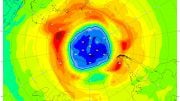
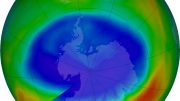
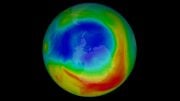
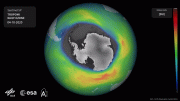
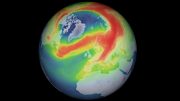
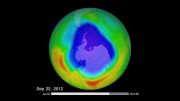
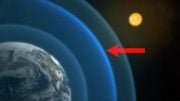
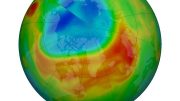
“…, we saw during 2019 a very special occurrence of an ozone hole that was really much smaller than all other ozone holes and this was caused by warm air slowing down the winds around the South Pole.”
There is a saying that, “One swallow does not a Spring make.” If an OLS regression trend line is fitted to all the maximum area-measurements from 1987 to today, there is a slight upward (albeit probably not statistically significant) trend, not the implied downward improvement.
“This allows people in certain areas to choose whether to stay indoors on days when ozone concentration is particularly low.”
Much of the alarm over the so-called Ozone Hole was speculation about the potential damage from UV exposure. One needs to understand that the sun is NEVER directly above Ozone Hole, and when the ‘hole’ is at its greatest, the sun is low on the horizon and the rays have a long path length, with greater scattering and absorption than when the sun is high in the sky. Furthermore, there are typically anomalously high ozone concentrations outside the circumpolar vortex, much higher than in the tropical stratosphere where the ozone is created, which the rays pass through.
There are few actual measurements of surface UV to support the concerns. What I found when I created a model based on TOMS ozone data was that when the sun reached its highest point in the sky, when the UV would potentially be most intense, the polar ozone was back to its protective levels. Life has evolved to tolerate UV, and during the time that the ozone is low, the UV levels are invariably less than they are when the ozone is high!
This is great technology; however, the interpretive science is more like ‘gaslighting.’
Just look at the other SciTechDaily articles linked at the bottom of the article. “NASA Reports Arctic Ozone Depletion Hit Record Low in March”, oh good, “Ozone Hole Over the Antarctic Is One of the Largest and Deepest in Recent Years” oh no, “There’s a New Hole in the Ozone Layer – This One’s Over the Arctic” SOS….it’s fearporn.
They had parents worldwide slathering their children in carcinogenic sunscreens for a couple decades, because ozone hole over Antarctica? Now the kids can’t function, still masked and riddled with climate-anxiety. The ozone hole will become a terrifying problem again when researchers run low on climate-change grants.